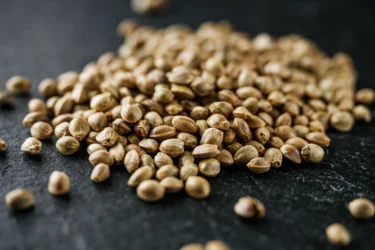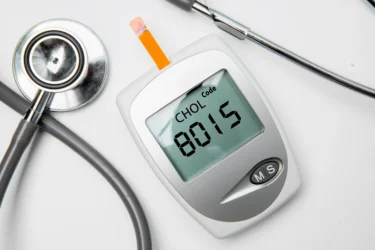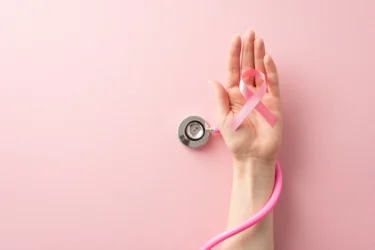In yoga, ‘mudras’ are believed to be the gateway to the storehouse of magnetic energy. A ‘mudra’ is a hand gesture or posture that has a specific pattern of fingers. As per Ayurveda, the human body is made of five elements, namely earth, water, fire, space, and wind. Likewise, the five fingers of our hands are known to represent these five elements: the thumb represents fire, the forefinger represents wind, the middle finger symbolizes space, the ring finger symbolizes the Earth, and the little finger represents water. During the practice of mudras, when we apply pressure to the tips of the fingers, it results in the activation of certain regions in the brain and offers numerous health benefits. In this article, we will explore the health benefits of one such mudra, Rudra Mudra1,2.
Rudra mudra belongs to the ‘hasta’ or the hand ‘mudra’ category and is believed to have a powerful healing effect. The name rudra mudra comes from the Sanskrit word ‘rudra’, which is another name for Lord Shiva, and ‘mudra’ means a seal lock or hand gesture. It is a mudra dedicated to Lord Shiva and involves the thumb, index, and ring fingers that symbolize fire, air, and earth elements of the body3.
Note: It is best to practice any mudra with a relaxed mind, closed eyes, and a normal breathing pattern.
Did You know?
Let us learn how to do the Rudra mudra3:
If you’re seeking to enhance your concentration, I would suggest considering the practice of Rudra Mudra. This mudra is believed to be potentially beneficial in improving focus and concentration6.
Dr. Siddharth Gupta, B.A.M.S, M.D (Ayu)
Keeping the origin and history in mind, let us now discuss the benefits of Rudra Mudra.
A sedentary lifestyle and unhealthy diets may increase the risk of hypertension. Literature studies have shown that eating a healthy diet, exercising, and doing yoga may help in managing blood pressure along with proper treatment. Nagarajan et al. conducted a study3 in 2017 that brought to light that the practice of rudra mudra, along with other mudras, helped in reducing blood pressure. Thus, the practice of rudra mudra may positively impact hypertension, but the practice of this mudra should not be considered an alternative to modern medicine. So, consult your doctor for proper treatment of hypertension and do not rely on this mudra alone. Additionally, one should practice rudra mudra under the supervision of a qualified trainer3.
Obesity, which has now become a lifestyle disorder, is characterized by excessive fat accumulation and an excessive increase in body weight. Literature studies state that the practice of asanas, mudras, and pranayamas may have a positive impact on health. A study3 conducted by Nagarajan et al. in 2017 explained that the practice of rudra mudra, along with other mudras, may be effective in reducing body weight and managing obesity. Additionally, the practice of this mudra may improve the metabolism of food and digestion by stimulating the manipura chakra. However, you should not consider the practice of this mudra as an alternative to modern medicine. You should consult your doctor for proper management of obesity3.
Depression is a mood disorder that is characterized by a feeling of sadness and loss of interest, which can affect daily activities. Literature studies show that the practice of asanas, pranayamas, and mudras may positively impact depression. Umesh Yadav, a Yogacharya at Jawaharlal Nehru University in 2021, stated8 that Rudra Mudra may help reduce stress and anxiety; this indicates that Rudra Mudra may have the potential to manage depression; however, you should not rely on this mudra alone and consult your doctor for proper treatment. Additionally, the practice of this mudra should be carried out under the guidance of a qualified trainer4.
Type II diabetes is characterized by increased blood glucose levels due to a deficiency or resistance to the insulin hormone, which is known to regulate blood glucose. Raveendran et al., in 2018, conducted a study4 that stated that the practice of hasta mudras may help reduce blood glucose levels and help manage type-II diabetes. Thus, the practice of rudra mudra may have the potential to show similar effects, but the practice of this mudra should not be considered an alternative to modern medicine. So, consult your doctor for proper treatment of Type-II diabetes and do not rely on this mudra alone. Additionally, one should practice rudra mudra under the supervision of a qualified trainer5.
Faulty postures and being inactive for long periods have increased the frequency of neck and back pain episodes. Literature studies support the practice of yoga asanas, pranayamas, and mudras, which may help in alleviating neck and back pain. Nagarajan et al. conducted a study3 in 2017 that stated that the practice of Rudra mudra may help manage neck and back pain, but the practice of this mudra should not be considered an alternative to modern medicine. You should consult your doctor for proper treatment of chronic neck and back pain. Further, it is advised to practice Rudra mudra under the guidance of a qualified trainer3.
Note- The benefits of rudra mudra are studied in a limited human population. Still, more research is needed to claim the positive effects of rudra mudra.
Rudra Mudra is a hand gesture that I often recommended for enhancing eyesight. Practising this mudra might have a positive impact on vision and may help improve eyesight over time when done consistently6.
Dr. Rajeev Singh, BAMS
Although the practice of yoga asanas, pranayamas, and mudras may help in the development of the mind and body, you should not consider them as an alternative to modern medicine. It is advised not to rely on mudras alone to treat any condition. Kindly consult a qualified doctor for proper treatment. Additionally, any mudra practice should be done under the supervision of a qualified trainer.
From my understanding, I have come to learn that practising Rudra Mudra might be beneficial in reducing cholesterol levels. It’s worth trying as a natural approach to boost your cardiovascular health7.
Dr. Smita Barode, B.A.M.S, M.S.
As mudras are practised along with yogasanas, the cautions that need to be taken during the practice of asanas should also be kept in consideration when performing mudras. Cautions need to be taken in the mentioned scenarios when performing rudra mudra:
As any mudra is practised along with yogasanas, the contraindications of yoga asanas will also apply to the practice of mudras. The following are the contraindications of rudra mudra:
Also Read: Benefits of Bhujangasana and How to Do It By Dr. Ankit Sankhe
Rudra mudra belongs to the hasta or the hand mudra category and is believed to have a powerful healing effect. The name Rudra Mudra comes from the Sanskrit word ‘rudra’, which is another name for Lord Shiva, and mudra means a seal lock or hand gesture. The practice of this mudra may help in exerting a positive impact on depression, hypertension, obesity, and back and neck pain.
Also Read: Benefits of Bhastrika Pranayama (Bellow’s Breath) and How to Do It By Dr. Ankit Sankhe
The name Rudra Mudra comes from the Sanskrit word ‘rudra’, which is another name for Lord Shiva, and mudra means a seal lock or hand gesture3.
Rudra mudra belongs to the hasta or the hand mudra category3.
The practice of this mudra may help in exerting a positive impact on depression, type II diabetes, obesity, and back and neck pain3,5.
There is limited information regarding the safety of Rudra Mudra during pregnancy. It is therefore advised to consult your doctor for proper guidance.
Yes, studies have shown that Rudra Mudra may have a positive impact on obesity. However, you should not rely on this mudra alone and consult your doctor for proper management of obesity4.
Disclaimer: The information provided here is for educational/awareness purposes only and is not intended to be a substitute for medical treatment by a healthcare professional and should not be relied upon to diagnose or treat any medical condition. The reader should consult a registered medical practitioner to determine the appropriateness of the information and before consuming any medication. PharmEasy does not provide any guarantee or warranty (express or implied) regarding the accuracy, adequacy, completeness, legality, reliability, or usefulness of the information; and disclaims any liability arising thereof.
Links and product recommendations in the information provided here are advertisements of third-party products available on the website. PharmEasy does not make any representation on the accuracy or suitability of such products/services. Advertisements do not influence the editorial decisions or content. The information in this blog is subject to change without notice. The authors and administrators reserve the right to modify, add, or remove content without notification. It is your responsibility to review this disclaimer regularly for any changes.
The seeds produced from the hemp plant are edible and nutritious. Scientifically, the hemp plant is the same as marijuana (Cannabis). Although they are related to the same genus, hemp seeds do not have the same activity as cannabis. Hemp seeds contain healthy fats, nutrients, and minerals, which provide numerous benefits to Human Health. Hemp is an ancient, unisexual plant known as Cannabis Sativa L., belonging to the family Cannabaceae. It is also referred to as industrial cannabis and is used in the energy, automobile, and construction markets. The seeds of hemp or cannabis are used as a functional food, a medicinal product, animal feed, and in the preparation of herbal formulations1,2. Let us discuss the importance and health benefits of Hemp seeds.
Nutritional contents of hemp seed per 100g2:
Did you know?

A study2 by Farinon et al.,2020, investigated the role of hemp seed in hypercholesterolemia caused by ovarian hormone deficiency. The experiment showed a positive result by providing unchanged levels of cholesterol and triglycerides in plasma with hemp seed supplements in the diet. This study reveals that hemp seed may potentially manage hypercholesterolemia, which develops due to ovarian hormone deficiency. More research concerning human efficacy needs to be conducted to validate the potential use of Hemp seeds2.

Leizer et al. 2000 reported3 that omega-3, 3 PUFA (Omega-3 Polyunsaturated Fatty Acids) present in hempseed oil may have an inhibitory effect on cancerous cells and might act as an anti-cancer agent. It has also shown inhibitory effects on tumour growth. Apart from Omega-3 PUFA, hemp seed oil also contains gamma-tocopherol in significant amounts, which also has anti-cancer properties. The gamma-tocopherol is known to inhibit the cancerous growth of colon cells and reduce the damage caused to the DNA by free radicals.
However, these hemp seeds have different bioactive compounds that may deactivate the free radicals. Further clinical data are needed for validation3. Cancer is a serious disease, and if you have any symptoms related to cancer, consult your doctor and do not self-medicate.

A study2 by Farinon et al. 2020 explained the potential functionality of hemp for human Health. Further, research studies have been conducted to validate the effect of hemp seed on fat deposition in arteries, commonly referred to as atherosclerosis. It was observed that supplementing hemp seeds with a high-fat diet may decrease cholesterol levels and may prevent atherosclerosis-related changes in the aorta (the artery responsible for carrying blood from the heart to other body parts). The consumption of hemp seeds also decreases triglyceride levels and inflammation, which may reduce oxidative stress. These findings suggested that hemp seed may have the potential against atherosclerosis, but more clinical trial data is required to establish its efficacy in humans2.

The anti-aging property of hemp seed is discussed by Farinon2 et al.,2020. They showed that hemp seed mixed with a vegetable diet might have a beneficial effect on promoting Health and longevity by significantly improving the morphology of the spleen and liver, gut flora, and memory, and decreasing inflammation. These findings suggest that hemp seed may slow the ageing process. However, more studies should be conducted to establish the true extent of its efficacy on humans2.

Acetylcholine is a chemical messenger which is responsible for the normal functioning of the body and brain. The acetylcholinesterase enzyme converts acetylcholine into choline and acetate. The acetylcholine synthesis decreases with age, but the acetylcholinesterase enzyme continues with its regular activity, leading to improper brain functioning. This improper brain functioning may affect memory and cognition in the long run, leading to dementia and Alzheimer’s disease. Potin and Saurel8, 2020 mention that hemp seeds’ protein can potentially inhibit the acetylcholinesterase enzyme. The inhibition of acetylcholinesterase may slow the progression of degeneration of brain diseases. Thus, it is suggested that hemp seed may have a potential for brain degeneration, but more research data is required to validate its efficacy in human health1.
Though studies show the benefits of Hemp seed in various conditions, these are insufficient, and there is a need for further studies to establish the true extent of the benefits of Hemp seed on human Health.
Based on my observations, hemp seed extracts contain antimicrobial, anti-inflammatory, anti-lipogenic, and collagen-promoting properties. Due to the presence of these properties, hemp seeds might be quite useful in reducing the occurrence of acne6.
Dr. Siddharth Gupta, B.A.M.S, M.D (Ayu)
Hemp seeds are healthy and nutritious nuts used by humans for various purposes. Some of the uses of hemp seed are:
One should always consult an Ayurvedic physician before consuming hemp seeds in large quantities or for therapeutic benefits. They will be the best person to prescribe the correct form and dosage for your health condition.
Some studies show that hemp seeds are a rich source of omega-3 fatty acids. These omega-3 fatty acids have anti-inflammatory properties. Due to these properties, hemp seeds might help in altering micro-organisms of the digestive tract which leads to improved digestion7.
Dr. Rajeev Singh, BAMS
Also Read: Stone Flower (Kalpasi): Uses, Benefits, Side Effects & More!
People suffering from gastric irritations, ulcers, and poor metabolism should avoid using hemp seed. Pregnant and lactating mothers, the elderly, and children should use the hemp seed and its oil only after consultation with a doctor.
Also Read: Sadabahar (Periwinkle): Uses, Benefits, Side Effects and More By Dr. Rajeev Singh
Since cannabinoids, one of the constituents of hemp seeds, may increase the risk of bleeding in patients taking warfarin (an anticoagulant). People must avoid the consumption of hemp seed and consult doctors when on medication5.
Also Read: Chitrakadi Vati: Uses, Benefits, Side Effects & More!
Hemp seeds contain protein, carbohydrates, and healthy fats, which make them edible as a nutritional product. It also comprises potassium, sodium, iron, magnesium, and calcium, which adds to its nutritional value2.
Hemp seed is beneficial to human health in various ways. It acts as an anti-cancer and anti-hypertensive. It may also help in managing the degeneration of brain cells and atherosclerosis. Hemp seeds may also improve the absorption of calcium in bones. If you have the above-mentioned issues, consult the doctor and do not self-medicate1,2,3..
The chemical constituents of hemp seeds may act as anti-nutritional agents. These agents may decrease the absorption of nutrients in the body. This property of the chemical components reduces the nutritional value of the product2. If you want to include the hemp seeds, consult your doctor and do not self-medicate.
Hemp seed may help increase the longevity of cells and improve the morphology of various organs in the body, like the spleen and liver. It may also enhance learning and memory along with locomotor activity2. But, before taking these hemp seeds, consult your doctor and do not self-medicate.
People on anticoagulants (blood thinners) must avoid consuming hemp seeds. In addition, pregnant and lactating females, the elderly, and children should consult the doctor before consuming hemp seed5.
Disclaimer: The information provided here is for educational/awareness purposes only and is not intended to be a substitute for medical treatment by a healthcare professional and should not be relied upon to diagnose or treat any medical condition. The reader should consult a registered medical practitioner to determine the appropriateness of the information before consuming any medication. PharmEasy does not provide any guarantee or warranty (express or implied) regarding the accuracy, adequacy, completeness, legality, reliability, or usefulness of the information; and disclaims any liability arising thereof.
Links and product recommendations in the information provided here are advertisements of third-party products available on the website. PharmEasy does not make any representation of the accuracy or suitability of such products/services. Advertisements do not influence the editorial decisions or content. The information in this blog is subject to change without notice. The authors and administrators reserve the right to modify, add, or remove content without notification. It is your responsibility to review this disclaimer regularly for any changes.
Originating in the Vedic period, Ayurveda is an ancient Indian medicine system that relies on the principle that “life is an interplay of five elements-water, air, fire, space and earth.” Owing to Ayurveda, the knowledge of nature has been passed down from generation to generation. There are numerous ways to incorporate the science of Ayurveda into your life for healing; one such way is by using churnas, a mixture of herbs and natural ingredients. Trikatu churna is an age-old remedy used for some excellent health benefits. It is a mixture/powder (churna) of three (tri) most essential herbs (katu), namely adrak (ginger or Zingiber officinale), kali mirch (Black pepper or piper nigrum) and pippali (long pepper or Piper longum). In this article, we will learn more about Trikatu churna, its health benefits, side effects, precautions, etc1.
Did you know?
As already mentioned, Trikatu churna is a combination of Zingiber officinale, piper nigrum and piper longum3. All three herbs are rich in different nutrients and phytochemicals with medicinal value. The nutritional chart of Trikatu churna is given below:
Trikatu churna is rich in phytochemicals having a high medicinal value. The phytochemicals present in Trikatu churna include phytosterol, beta-sitosterol, acetic acid, amides, piperlongumine, genistein, E-beta carotene, etc2,5.
Trikatu churna shows numerous scientifically proven properties; some of which are mentioned below5:
Some of the potential benefits of Trikatu churna are described below.

Type II Diabetes is characterized by increased blood glucose due to reduced production or resistance to insulin (a hormone that regulates blood glucose). Ayurvedic formulations like churnas have been gaining the limelight for managing diabetes. Chabbra et al. conducted a study4 in 2022 that showed the presence of phytochemicals like genistein, piperlongumine, beta-sitosterol, beta-carotene, etc., in Trikatu churna. These phytochemicals regulate insulin resistance pathways and may help reduce blood glucose. Additionally, genistein may help improve insulin synthesis. This indicates that Trikatu churna may help manage Type II diabetes. However, to claim these results in humans, we need more studies. It is further advised not to self-medicate and consult your physician for proper management of diabetes5.

The liver is a large organ on the abdomen’s right side. It is mainly responsible for filtering waste from the body, including bilirubin, producing bile which helps to digest food and storing sugar in the body, which can later be used as an energy source. Different liver enzymes perform all these functions; any liver disease will be characterized by an abnormal value of these liver enzymes. Sharma et al. conducted a review1 that stated that Trikatu churna might exert a protective effect on the liver by improving liver enzymes and function. This may indicate that the Trikatu churna may protect the liver and help in conditions like alcoholic liver disease. However, more studies on humans are needed to support these claims. Additionally, it is advised not to rely on this churna as a remedy, and kindly consult your physician for the proper management of any liver disease1.

A lipid profile is a complete cholesterol test that measures total cholesterol, triglycerides, low-density lipoprotein (LDL), high-density lipoprotein (HDL), etc. Valsala et al., 2013 conducted an animal study5 to assess the effect of Trikatu churna on lipid profile. The consumption of this churna showed a declining trend in total cholesterol and triglycerides and helped increase high-density lipoprotein or good cholesterol levels. Thus, Trikatu churna may positively impact the lipid profile. However, we need more human studies to claim these results accurately. Also, it is advised not to consider this churna as an alternative to modern medicine; you should always consult your doctor for proper management of an abnormal lipid profile6.

Rheumatoid arthritis is a long-term inflammatory disease affecting the joints. It is manifested by inflammation and pain in the joints. Literature studies show that Trikatu churna may manage inflammatory conditions like rheumatoid arthritis. Vachana et al. conducted a study10 in 2014 which stated that Trikatu churna might help reduce inflammation due to the presence of phytochemicals like gingerol, piperine, etc. This indicates that Trikatu churna may potentially benefit rheumatoid arthritis and provide symptomatic relief. However, we need more studies to confirm these results with greater reliability. Additionally, you should not consider this churna as a remedy for managing rheumatoid arthritis; it is always advised to consult a physician for proper management7.

Digestive disorders are increasing globally and affecting people of all age groups. Christine et al. conducted a review6 in 2019 that stated that Trikatu churna might help improve digestion and gut flora and have a prebiotic effect. Additionally, it may have an anti-carminative effect (reduce flatulence) due to phytoconstituents like beta carotene, acetic acid, piperine, etc. Therefore, Trikatu churna may have the potential to manage digestive disorders and improve gut health. To claim these results in humans, we need more studies. It is further advised not to consider this churna as an alternative to modern medicine; kindly consider your doctor for proper management of any digestive disorder8.

Though there are studies that show the benefits of Trikatu churna in various conditions, these are insufficient and there is a need for further studies to establish the true extent of the benefits of Trikatu churna on human health.
Trikatu churna is believed to possess anti-inflammatory, anti-dyslipidaemic, and immune-modulatory characteristics and it might suppress certain pro-inflammatory cytokines. Based on some studies, Trikatu churna might be beneficial for managing COVID-19 cases11.
Dr. Siddharth Gupta, B.A.M.S, M.D (Ayu)
You must consult a qualified doctor before taking any herbal supplements. Do not discontinue or replace an ongoing treatment of modern medicine with an ayurvedic/herbal preparation without consulting a qualified doctor.
Also Read: Banana Leaf: Uses, Benefits, Side Effects By Dr. Smita Barode
Chanda et al. conducted an animal study7 that found Trikatu churna to be safe; however, there are no studies conducted on humans to assess the side effects of Trikatu churna. You should avoid excessive consumption of this churna as it may cause your blood glucose and lipid levels to drop too low.
However, if you experience any adverse reactions to Trikatu churna, it is advised to discontinue its intake and immediately contact a doctor or your Ayurvedic physician who has prescribed it. They will be able to guide you appropriately for your symptoms5,6,8.
Trikatu churna might be beneficial for managing various health issues like colds, coughs, nasal congestion, etc. Due to the presence of various phytochemicals, it might possess anti-microbial, anti-fungal, and analgesic properties and might be useful as a go-to remedy in common health conditions12.
Dr. Rajeev Singh, BAMS
Consuming Trikatu churna is okay if taken in moderate amounts. However, caution is warranted if you belong to special groups, as under:
Also Read: Gokshuradi Guggulu: Uses, Benefits, Side Effects and more!
However, you must always seek the advice of your Ayurvedic physician about the possible interaction of Trikatu churna with other drugs and follow the prescription thoroughly, as they will know your health condition and other medications you are taking.
Also Read: Talisadi Churna: Uses, Benefits and Side Effects By Dr. Rajeev Singh
Trikatu churna is an age-old remedy used for some excellent health benefits. It is a mixture/powder (churna) of three (tri) most essential herbs (katu), namely adrak (ginger or Zingiber officinale), kali mirch (Black pepper or piper nigrum) and pippali (long pepper or Piper longum)1.
Yes, Trikatu churna may help in weight loss and, thus, help manage obesity1.
Yes, Trikatu churna may help in the treatment of cough.
No, there are no proven results for the effects of Trikatu churna on hair loss.
The safety of Trikatu churna consumption in pregnancy is not well-established; it is therefore advised to avoid its use and consult your doctor for the same.
Disclaimer: The information provided here is for educational/awareness purposes only and is not intended to be a substitute for medical treatment by a healthcare professional and should not be relied upon to diagnose or treat any medical condition. The reader should consult a registered medical practitioner to determine the appropriateness of the information and before consuming any medication. PharmEasy does not provide any guarantee or warranty (express or implied) regarding the accuracy, adequacy, completeness, legality, reliability or usefulness of the information; and disclaims any liability arising thereof.
Links and product recommendations in the information provided here are advertisements of third-party products available on the website. PharmEasy does not make any representation on the accuracy or suitability of such products/services. Advertisements do not influence the editorial decisions or content. The information in this blog is subject to change without notice. The authors and administrators reserve the right to modify, add, or remove content without notification. It is your responsibility to review this disclaimer regularly for any changes.
“With the changing times, not only the country’s policymakers but the whole world is realising the importance of Ayurveda. Who would’ve thought that people in the upcoming generations would prefer a bottle of gooseberry or bottle gourd juices over carbonated drinks?” Despite this realization of the health benefits of plants and fruits, there are fruits like Phalsa which, although are high in nutrients but low in popularity. Phalsa is a plant that originates in Southeast Asian countries like India, Nepal, Sri Lanka and Bangladesh and is mainly grown for its fruit. The scientific name of the Phalsa fruit is Grewia asiatica, also known as the Indian Sherbet berry. It is a seasonal plant and the fruits are generally obtained in the summer. Phalsa fruit resembles grapes in its shape and size. They are purple in colour with a sour-sweet taste. The fruit is a powerhouse of vitamins and minerals and offers many health benefits; let us know more about those benefits1.
Phalsa fruit is rich in carbohydrates, fibres, proteins, vitamins A, B3 and C and minerals like potassium, calcium, iron and phosphorus. The phytochemicals present in Phalsa fruit include anthocyanins, tannins, phenols and flavonoids. The nutritional chart of this fruit is given below.
Phalsa fruit shows numerous scientifically proven properties; some of which are mentioned below1:
I’ve discovered that Phalsa fruits have a cooling effect on the body. Phalsa fruit is rich in phenols. This property makes it a potential natural remedy for excessive body heat9.
Dr. Siddharth Gupta, B.A.M.S, M.D (Ayu)
Some of the potential benefits of Phalsa fruit are described below.

Diabetes (Type I & II) is characterised by an increase in blood glucose due to a reduction or resistance to insulin (a hormone that regulates blood glucose). Literature shows that fruits rich in polyphenols may positively impact diabetes. Parveen et al. conducted a study2 on diabetic rabbits in 2013 to assess the effect of Phalsa fruit on blood glucose. This study showed a reduction in rabbits’ blood glucose after administering Phalsa fruit. Additionally, this fruit has a low glycemic index and the presence of polyphenols may help reduce blood glucose levels. This indicates that Phalsa fruit may help manage diabetes. However, to claim these results in humans, we need more studies. It is further advised not to self-medicate and consult your physician for proper management of diabetes3.

Dyslipidemia is characterised by an increase in total cholesterol and triglycerides. Studies have shown that Phalsa fruit may potentially control the altered parameters in dyslipidemia. An animal study4 conducted by Parveen et al. in 2013 showed a positive relationship between the consumption of this fruit and lipid levels. Rabbits administered Phalsa fruit extract (200mg/kg) showed reduced total cholesterol and triglycerides. This may indicate that this fruit’s consumption may help manage dyslipidemia. However, more studies on humans are needed to support these claims. Additionally, it is advised not to rely on Phalsa fruit as a remedy for managing dyslipidemia and kindly consult your physician for the proper management of dyslipidemia.

Breast cancer is one of the most common cancers affecting women worldwide; different ayurvedic treatments are being tested for their effectiveness towards breast cancer. A review2 by Muhammed et al. in 2013 states that Phalsa fruit contains smart molecules called anthocyanins which help reduce the multiplication of abnormal cells and the risk of cancers. Thus, it may be concluded that Phalsa fruit may reduce breast cancer risk. However, we need more human studies to claim these results accurately. Also, it is advised not to consider Phalsa fruit as an alternative to modern medicine; you should always consult your doctor for proper management of breast cancer.

Traditionally, herbs, spices, leaves and fruits obtained from plants were used for managing bacterial infections. Muhammed et al. conducted a review2 in 2013 to test the efficacy of Phalsa fruit on different bacteria. The presence of polyphenols in Phalsa fruit inhibited the growth of S.typhi bacteria; thus, it may have the potential to manage bacterial infections like Typhoid caused by S.typhi bacteria. However, we need more studies to confirm these results in humans. Additionally, you should not consider Phalsa fruit as a remedy for managing Typhoid; it is always advised to consult a physician for proper management of Typhoid.

Depression is a mood disorder that results in sadness and loss of interest and may affect everyday activities. Previous studies have shown that healthy nutrition may help in managing various ailments. A study4 conducted by Imran et al. in 2021 stated that Phalsa fruit, due to the presence of antioxidants like phenols, anthocyanins, flavonoids, etc., may help in managing depression. Additionally, this fruit can potentially reduce anxiety (anxiolytic effect). Therefore, Phalsa fruit may have the potential to manage depression. To claim these results for humans, we need more studies. It is further advised not to consider Phalsa fruit as an alternative to modern medicine; kindly consider your doctor for proper management of depression5.

Though there are studies that show the benefits of Phalsa fruit in various conditions, these are insufficient and there is a need for further studies to establish the true extent of the benefits of Phalsa fruit on human health.
Let me give you a tip! Phalsa fruit might take care of your skin. Phalsa fruit is rich in antioxidants and numerous vitamins and minerals, which makes Phalsa a potential contributor to achieving flawless skin10.
Dr. Rajeev Singh, BAMS
You must consult a qualified doctor before taking any herbal supplements. Do not discontinue or replace an ongoing treatment of modern medicine with an ayurvedic/herbal preparation without consulting a qualified doctor.
Phalsa fruit is considered safe when eaten in minimal amounts. A few side effects related to the consumption of Phalsa fruit include:
However, if you experience any adverse reactions to Phalsa fruit, it is advised to discontinue its intake and immediately contact a doctor or your Ayurvedic physician who has prescribed it. They will be able to guide you appropriately for your symptoms.
Also Read: Mango (Aam): Uses, Benefits, Side Effects by Dr. Smita Barode
Consuming Phalsa fruit is okay if taken in moderate amounts. However, general precautions must be followed in the following conditions1:
Also Read: Hadjod (Cissus Quadrangularis): Uses, Benefits, Side Effects & More!
However, you must always seek the advice of your Ayurvedic physician about the possible interaction of Phalsa fruit with other drugs and follow the prescription thoroughly, as they will know your health condition and other medications you are taking.
Also Read: Shallaki (Boswellia serrata): Uses, Benefits, Side Effects & More!
Phalsa fruit resembles grapes in its shape and size. They are purple in colour and sour to sweet in taste1.
Phalsa fruit is called Grewia asiatica1.
In Hindi, Phalsa fruit is called Sherbet berry.
No, there are no proven results on the efficacy of the Phalsa fruit for reducing weight.
The safety of Phalsa fruit consumption in pregnancy is not well-established; it is therefore advised to consult your doctor if you plan to add Phalsa fruit to your diet.
Disclaimer: The information provided here is for educational/awareness purposes only and is not intended to be a substitute for medical treatment by a healthcare professional and should not be relied upon to diagnose or treat any medical condition. The reader should consult a registered medical practitioner to determine the appropriateness of the information and before consuming any medication. PharmEasy does not provide any guarantee or warranty (express or implied) regarding the accuracy, adequacy, completeness, legality, reliability or usefulness of the information; and disclaims any liability arising thereof.
Links and product recommendations in the information provided here are advertisements of third-party products available on the website. PharmEasy does not make any representation on the accuracy or suitability of such products/services. Advertisements do not influence the editorial decisions or content. The information in this blog is subject to change without notice. The authors and administrators reserve the right to modify, add, or remove content without notification. It is your responsibility to review this disclaimer regularly for any changes.
“Ayurveda, a most sacred science of life, is beneficial to humans both in this world and the world beyond”. Ayurveda focuses on improving human health and well-being through herbs and spices. One such herb which is of great significance is Madhunashini. Madhunashini is also known as meshashringi (Sanskrit), gurmar and merasingi (Hindi), vakundi, kavuli and kalikardori (Marathi), dhuleti and mardashingi (Gujarathi), Podapatri (Telugu) and Cherukurinja (Tamil). The scientific or botanical name of Madhunashini is Gymnema sylvestre and it belongs to the Asclepiadaceae family. It is a medicinal woody climber native to western and Central India, Australia, and tropical Africa. In India, it is widely grown in Bihar, Chhattisgarh Andhra Pradesh, Kerala, Karnataka, Uttar Pradesh, Madhya Pradesh, and West Bengal. The leaves, flowers, and root extracts have medicinal properties. Let us know more about the health benefits of this wonder plant1,2.
Madhunashini has nutrients like carbohydrates, proteins, and other phytochemical constituents like saponins, sterols, terpenoids, glycosides, alkaloids, resins, etc3.
Did you know?
Scientifically proven properties of Madhunashini include1:
Based on my experience, I have found that the leaf extract of madhunashini might have antiarthritic effects. The extract contains certain compounds that could potentially inhibit inflammation and reduce the release of pain-causing substances, which may help in managing arthritic symptoms8.
Dr. Siddharth Gupta, B.A.M.S, M.D (Ayu)
Some of the potential benefits of Madhunashini are described as under:

We can’t deny that diabetes is one of the most common diseases, showing an increasing trend worldwide. Even in their 20s, youngsters have complaints of high blood glucose levels because of unhealthy dietary choices and a sedentary lifestyle. A review1 by Kanetkar et al. in 2007 stated that Madhunashini exerts anti-diabetic effects due to the presence of gymnemic acids. The possible mechanism attributed is an increase in insulin secretion, a hormone that regulates blood glucose. Additionally, gymnemic acids help inhibit glucose absorption from the intestine and increase glucose utilization. This indicates that Madhunashini may help manage diabetes. However, more studies are needed to support these claims with greater reliability1.

A lipid profile is a blood test that measures the number of triglycerides and cholesterol in the blood. An altered lipid profile is a risk factor for diseases like atherosclerosis, pancreatitis, etc. Eisenberg et al. 2003 conducted a study8 in rats. This study showed that Madhunashini leaf extracts could reduce serum triglycerides, low-density lipoprotein, total cholesterol, etc. This indicates that Madhunashini has the potential to correct an abnormal lipid profile. However, these results are based on animal studies and more studies are needed to claim these effects in humans4.

Obesity is a complex disease characterized by excess body fat, which can negatively affect health. Studies have supported the fact that using food sources in the right quantity and the use of complementary and alternative medicine like yoga and ayurvedic herbs may help in weight loss. A review4 conducted by Fabio et al. in 2013 stated that Madhunashini has the potential to manage obesity. This effect is attributed to inhibiting taste perception by gymnemic acids present in Madhunashini leaf and root extracts which may limit your food intake. This indicates that the Madhunashini may aid weight loss by decreasing the intake of calories. However, we need more studies to support these claims with greater reliability4,5.

Cancer is a disease in which cells of the body may multiply abnormally and form cancerous cells that may spread to other parts of the body. A review4 conducted by Fabio et al. in 2013 states that Madhunashini may help manage breast and lung cancer. The exact mechanism behind this effect is, however, still being determined. This indicates that Madhunashini may help with cancer. However, scientific evidence supporting these claims is limited. Therefore, we need more studies to support these claims4.

Many antibacterial agents in Ayurveda have been used for managing bacterial infections; one such agent is Madhunashini. A review4 conducted by Fabio et al. in 2013 stated that Madhunashini leaf extract might have antibacterial activity against bacteria like E.coli and Salmonella species. By killing these bacteria, Madhunashini may help manage urinary tract infections, diarrhoea, typhoid, etc. This indicates that it may help manage a wide range of bacterial infections. Additionally, it may also help in managing dental caries, usually caused by bacteria, and thus may help improve dental hygiene. However, there is no scientific study done on humans to support these claims4.

Though there are studies that show the benefits of Madhunashini in various conditions, these are insufficient, and there is a need for further studies to establish the true extent of the benefits of Madhunashini on human health.
In my experience, madhunashini extract may have potential benefits in wound healing. The extract contains flavonoids, which are known for their antioxidant properties. While further studies are needed, incorporating its extract in wound care may support the healing process8.
Dr. Rajeev Singh, BAMS
You must consult a qualified doctor before taking any herbal supplements. Do not discontinue or replace an ongoing treatment of modern medicine with an ayurvedic/herbal preparation without consulting a qualified doctor.
Did you know that the root bark of Madhunashini has been historically used as an emetic, expectorant, and analgesic for body aches? It has also been utilized as a traditional remedy for snakebites, with the root juice playing a role in its treatment8.
Dr. Smita Barode, B.A.M.S, M.S.
However, if you experience any adverse reactions to Madhunashini, it is advised to discontinue its intake and immediately contact a doctor or your Ayurvedic physician who has prescribed it. They will be able to guide you appropriately for your symptoms.
Also Read: Gokshuradi Guggulu: Uses, Benefits, Side Effects and more!
Consuming Madhunashini is okay if taken in moderate amounts. However, general precautions must be followed in the following conditions7:
Also Read: Vasaka (Malabar Nut): Uses, Benefits and Side Effects by Dr. Rajeev Singh
However, you must always seek the advice of your Ayurvedic physician about the possible interaction of Madhunashini with other drugs and follow the prescription thoroughly, as they will know your health condition and other medications you are taking7.
Also Read: Triphala: Uses, Benefits, Side Effects & More!
Madhunashini is also known as meshashringi (Sanskrit), gurmar and merasingi (Hindi), vakundi, kavuli and kalikardori (Marathi), dhuleti and mardashingi (Gujarathi), Podapatri (Telugu) and Cherukurinja (Tamil)1.
The scientific name of the Madhunashini plant is Gymnema sylvestre, which belongs to the Asclepiadaceae family1.
No, there are no interactions of Madhunashini with food7.
Yes, it is available in the market as Madhunashini tablet, capsules, extract, powder, paste, etc6.
Madhunashini in Tamil is known as Cherukurinja1.
Disclaimer: The information provided here is for educational/awareness purposes only and is not intended to be a substitute for medical treatment by a healthcare professional and should not be relied upon to diagnose or treat any medical condition. The reader should consult a registered medical practitioner to determine the appropriateness of the information and before consuming any medication. PharmEasy does not provide any guarantee or warranty (express or implied) regarding the accuracy, adequacy, completeness, legality, reliability or usefulness of the information; and disclaims any liability arising thereof.
Links and product recommendations in the information provided here are advertisements of third-party products available on the website. PharmEasy does not make any representation on the accuracy or suitability of such products/services. Advertisements do not influence the editorial decisions or content. The information in this blog is subject to change without notice. The authors and administrators reserve the right to modify, add, or remove content without notification. It is your responsibility to review this disclaimer regularly for any changes.
With rising health awareness, people around the world are exploring foods with wonderful nutrients and health benefits. A millet that has gained popularity recently is Kutki. It is scientifically known as Picrorhiza kurroa Royle ex. Benth. It belongs to the family Plantaginaceae. It is mainly grown at 3000-5000 m. above sea level in the Himalayan region of India, Nepal, Pakistan, western China, Tibet and Burma1.
Kutki is a small annual herb with a long root, creeping stems and oval leaves. The plant is harvested from October to December1. It is known by different names in different languages and regions. Kutki in English is called hellebore, kutki in Hindi is called as tikta, kaurohini, kavi, tiktarohini, kauka, sutiktaka, and rohini, kutki in Tamil is katuka rohini, kadugurohini, and katuku rohini whereas kutki in Malayalam is katuka rohini and kaduk rohini2.
In our article, we have described the roots of kutki. These are bitter to taste and their extract is used for medicinal purposes. Kutki herb benefits are recorded in the Ayurveda Samhitas1. Keep scrolling down to read about the kutki benefits and side effects!
Friendly Reminder: The information shared here is for educational purposes only and the reader should consult a registered medical practitioner before implementing any changes to their health routine.
Did you know?
Kutki has many phytochemicals. A few of the chemical constituents of kutki are as follows1:
Although more research is required to understand the nutritional value of kutki, according to B & B organics, the nutritional value of kutki is as follows:
According to my experience, to get maximum health benefits from Kutki, you must take them in certain dosages. For example, for fatty liver, you must take Kutki root powder (2 to 3 gms) with warm water two times every day, at least for three months to see the effects. However, you must avoid self-medication and always opt for medical advice before its use5.
Dr. Siddharth Gupta, B.A.M.S M.D (Ayu)
Kutki might have the following properties1:
The existing studies show the following kutki health benefits:

Blood sugar levels in diabetes are high that cause damage to the eyes, bones, heart and other organs. A study2 by Joy et al. in 1999 on rats showed that extracts from kutki can lower blood sugar levels. It also showed that it could reduce the damage caused by a chemical called alloxan in diabetes, which may prevent further complications of diabetes. The study proves that kutki extracts might be helpful for people with diabetes. However, before taking it, you should consult a doctor and understand the benefits of kutki powder for diabetes.

Obesity is an inflammatory and metabolic disorder that occurs due to excess accumulation of fat in the body tissue that releases various inflammatory mediators that can cause cellular damage. A study1 by Almeleebia et al. in 2022 showed that the root extracts of kutki can reduce the levels of inflammatory mediators involved in inflammatory processes. Therefore, kutki might help with inflammation and inflammatory diseases, but you should always consult a doctor regarding kutki benefits.

Bacteria and fungi can enter the body and release toxins that can cause infection in the eyes, nose, skin, lungs and other body organs. A study1 by Almeleebia et al. in 2022 showed that the phytochemicals found in the kutki extracts could inhibit the growth of bacteria and fungi in the body and may help in managing bacterial and fungal infections. However, it is advised not to self-medicate. You should consult the doctor regarding kutki powder benefits and seek treatment accordingly.

Cancer is the second leading cause of death worldwide. A study3 by Rajkumar et al. in 2011 found that kutki extracts are rich in flavonoids, phenolic acids, and antioxidants that can stimulate the cell death process in cancerous cells of the breast, liver, and prostate cancer. The study shows that kutki might help in slowing the progression of cancer. However, if you suspect cancer, do not self-medicate. Consult your doctor regarding the benefits of kutki and seek treatment accordingly.

The liver is a major organ that plays a vital role in the absorption of fat, synthesis of hormones and detoxification of the body. A study1 by Almeleebia et al. in 2022 showed that kutki benefits in liver-related issues such as jaundice, recurrent fever and viral hepatitis. Its extracts have kutkin, which protects the liver by suppressing substances that can harm liver health. The phytochemicals in kutki extracts also help in reducing the liver toxicity caused by alcohol. Although more research is required to understand the benefits of kutki for liver cirrhosis, the study shows that kutki might help manage liver diseases. However, you should not self-medicate with it and consult the doctor regarding kutki benefits for the liver.

When stomach or intestinal linings get damaged because of the acid present, it causes stomach or intestinal ulcers. A study1 by Almeleebia et al. in 2022 showed that kutki root extracts have a protective effect on the stomach. It can reduce ulcers caused by a medicine named Indomethacin. The extract promotes mucus formation, which protects the stomach and intestinal lining from ulcer formation. It also lowers the production of chemicals involved in ulcer formation. The study shows that kutki might help those struggling with ulcers1. However, you should consult with a doctor instead of self-medicating.

Let’s see some more kutki medicinal uses1:
Although with the advancement in knowledge and technology, new research methods are employed to study the health benefits of kutki, they still need to be improved, and further studies are required.
I would suggest following the dosage of Kutki powder for its benefits for fever, high cholesterol, gastritis, and hepatitis. For fever, you must boil two gms of Kutki powder in 100 ml of water till it reduces to 1/4th of its initial quantity. Similarly, two gms of Katuki powder mixed with sugar after a meal two times a day can be beneficial in gastritis. For high cholesterol and hepatitis, Kutki powder should be mixed with Haridra powder and Bhumya Malaki, respectively.
Dr. Rajeev Singh, BAMS
Kutki can be used in the following ways:
You must consult a qualified doctor before taking any herbal supplements. Do not discontinue or replace an ongoing treatment of modern medicine with an ayurvedic/herbal preparation without consulting a qualified doctor.
Consuming kutki formulations in healthy amounts is considered safe. However, a study by Almeleebia et al. in 2022 showed that the highest safe dose of kutki in a day is 2000mg/kg, any dose above it may have noticeable side effects.
Although there are insufficient studies on humans to study the kutki powder side effects, it is best to consult a doctor if you notice any unusual symptoms.
Also Read: Dark Chocolate: Uses, Benefits, Side Effects By Dr. Smita Barode
A few of the important precautions that should be taken when using kutki are as follows:
The important contraindications where the use of Kutki is not advised:
Also Read: 8 Effective Herbs To Lower Blood Sugar Levels!
There is not enough evidence on the interaction of the kutki extracts with other drugs. Further studies are required. Therefore, you must consult your doctor before consuming kutki along with your prescribed medication.
Also Read: Ashoka Tree: Uses, Benefits, Side Effects and More!
Kutki churna benefits in constipation, skin problems, jaundice, heart problem, allergy, digestion, obesity, and breathing problems.
Kutki is also known as katuka, Katuki, Kuru, Kurri, Katuko, Katukarogani, Kadu, Kutka, HuHuang Lian, Hellbore and Picrorhiza.
Although more research is required to understand the benefits of kutki for fatty liver, there are many kutki uses in ayurveda for managing liver diseases. Kutki benefits in managing viral hepatitis, recurrent fever, and alcohol-induced fatty liver.
Kutki formulations should be stored at 50 degrees for three months. Additionally, it should not be consumed during pregnancy. It is advised that children, the elderly and breastfeeding mothers should consult a doctor regarding kutki side effects before consuming it.
Kutki powder should not be consumed by pregnant women. It can cause serious side effects in the mother as well as the unborn baby. So, it is best avoided in any form.
Disclaimer: The information provided here is for educational/awareness purposes only and is not intended to be a substitute for medical treatment by a healthcare professional and should not be relied upon to diagnose or treat any medical condition. The reader should consult a registered medical practitioner to determine the appropriateness of the information and before consuming any medication. PharmEasy does not provide any guarantee or warranty (express or implied) regarding the accuracy, adequacy, completeness, legality, reliability or usefulness of the information; and disclaims any liability arising thereof.
Links and product recommendations in the information provided here are advertisements of third-party products available on the website. PharmEasy does not make any representation of the accuracy or suitability of such products/services. Advertisements do not influence the editorial decisions or content. The information in this blog is subject to change without notice. The authors and administrators reserve the right to modify, add, or remove content without notification. It is your responsibility to review this disclaimer regularly for any changes.
Chayote, scientifically known as Sechium edule, is a climbing plant belonging to the Cucurbitaceae family. Initially grown in Mexico and Guatemala, it was later introduced to the United States, Europe, Africa, China, and South-Asian countries. Nowadays, it is grown throughout the world in tropical and subtropical areas1.
There are two major varieties of chayote plants, namely, the commercial variety and the wild type.1 Commonly chayote is known by different names such as vegetable pear, cho cho, chow-chow, sayote, pear squash, christophene, chuchu, guisquil, and iskus2.
The plant’s edible parts are its fruits, stems, leaves, and roots. Chayote fruits are bright green and pear-shaped. There are many medicinal benefits of chayote owing to the bioactive compounds such as sterols, cucurbitacins and polyphenol compounds present in it1.
Chayote has high nutrient value and is loaded with essential vitamins, minerals, fibers, and antioxidants. According to the US Department of Agriculture, the nutritional value of 100g of Chayote is as follows4:
Existing studies suggest that chayote may offer the following potential benefits as a part of overall health:
Diets high in saturated fats can lead to fat build-up in the arteries, making it harder for the heart to pump blood efficiently. Chayote is low in fat and contains fibre and antioxidants, which may support heart health by helping to manage cholesterol levels as part of a balanced diet.
A study8 found that extracts of Chayote help in the treatment of heart diseases by influencing the function of the smooth muscles of the arteries. Additionally, chayote is rich in fibres, and studies have shown that dietary fibres may prevent heart diseases9. However, if you have a heart condition, don’t replace your medications with chayote. It is best to consult a doctor and seek treatment accordingly.
Diabetes is a medical condition in which blood has high levels of sugar. A review study found that the natural antioxidants in the vegetables like chayote may maintain glucose balance in the body and reduce sugar spikes after meals10. Additionally, the rich fibrous content of the chayote may help in managing blood sugar levels by slowing down the absorption of carbohydrates, resulting in reduced blood sugar levels after eating. The chayote extracts may reduce blood sugar levels3. Consult a doctor to know if consuming chayote is right for you in supporting diabetes management.
Women require specific nutrients like folate, iron, calcium, and essential vitamins to support a healthy pregnancy2. Chayote is a good source of folate, a vital nutrient during pregnancy that supports the healthy development of the baby’s brain and spinal cord. Research has shown that adequate folate intake may help reduce the risk of premature delivery and neural tube defects. Including chayote as part of a balanced diet may contribute to a healthy pregnancy. It can also help in lowering blood pressure in pregnant women; however, it is important to consult a healthcare professional rather than relying on self-medication11,12.
Cancer is a medical condition where the body’s cells abnormally multiply, affecting its normal functioning. A study5 found that chayote may inhibit the multiplication of cancerous cells and promote cell death. Studies13 have also found that chayote fruits may help in the treatment of acute myeloid leukemia. Additionally, the chayote leaf extracts may inhibit the multiplication of breast cancer cells14. However, if you suspect cancer, instead of self-medicating, you should consult a doctor to understand chayote leaves’ health benefits and seek treatment accordingly.
Antioxidants may protect the body against cellular damage and reduce inflammation. A study has shown that free radicals may damage the body cells, reduce the body’s functioning over time, and accelerate ageing. Studies15 show that antioxidants from chayote can protect the cells from harmful effects of UV rays, reduce cell damage, and slow down the signs of ageing16. Chayote is rich in antioxidants and vitamin C and may benefit the skin by promoting collagen production that may reduce the visible signs of ageing such as wrinkles, fine lines, and pigmentations1. However, you should always consult a doctor instead of self-medicating to get chayote leaves benefits.
Fatty liver disease occurs when excessive fat accumulates in the liver, affecting its normal function. Some studies have indicated that extracts from chayote may help protect liver tissue by reducing fat deposition. While these findings are promising, further research is needed, and dietary changes should always be discussed with a healthcare professional7. More research is required to understand how chayote squash benefits liver functioning. If you have a fatty liver, you should consult a doctor instead of self-medicating.
Other potential uses of chayote squash vegetable are as follows:
In traditional medicine, decoctions made from the leaves or fruit of chayote have been used for their potential diuretic properties. They have been traditionally applied to help relieve burning sensations during urination, support kidney health, and manage certain respiratory discomforts. However, these uses are based on traditional practices, and scientific evidence is limited. Anyone considering such remedies should consult a qualified healthcare professional8.
Chayote fruit is rich in vitamin A and E, both of which are essential for normal bodily functions. Vitamin A may support good vision, reproductive health, and the health of your blood, while vitamin E might be crucial for maintaining a healthy brain and glowing skin19.
Dr. Siddharth Gupta, B.A.M.S, M.D (Ayu)
Chayote can be used in the following ways:
You must consult a qualified doctor before taking any herbal supplements. Do not discontinue or replace an ongoing treatment of modern medicine with an ayurvedic/herbal preparation without consulting a qualified doctor.
No significant side effects have been scientifically documented in relation to the moderate consumption of chayote as part of a normal diet. It is well-tolerated by most people and is not known to cause adverse effects when properly prepared and consumed in typical amounts.
General precautions must be followed while consuming chayote. Here is a list of a few precautions.
Also Read: Ber Fruit (Jujube): Uses, Benefits, Side Effects & More!
There is not enough evidence on the interaction of the chayote extracts with other drugs. Further studies are required. Therefore, you must consult your doctor if you are on any other medication before consuming chayote.
There is a traditional belief that chayote leaves may help in the natural elimination of kidney stones. They have been used in some cultures with the view that their properties might support the breakdown of kidney stones. However, scientific research on this specific use is currently limited19. It is important to consult a medical professional for proper diagnosis and treatment of kidney stones rather than relying solely on traditional remedies.
Dr. Rajeev Singh, BAMS
Chayote recipes can be enjoyed in both savoury and sweet dishes. Here are a few chayote recipe ideas to inspire your culinary creativity:
Make a refreshing salad by thinly slicing chayote and mixing it with your favourite vegetables, such as tomatoes, onions, and bell peppers. Toss the salad with a zesty vinaigrette dressing for a crisp and healthy side dish.
Stuffed chayote is a flavourful and satisfying dish in which chayote halves are filled with a seasoned mixture, commonly containing ground meat, vegetables, and herbs. The filled chayotes are then baked or cooked until tender, allowing the mild flavour of the vegetable to blend beautifully with the savoury stuffing. This dish serves as a hearty, protein-rich main course and a wholesome addition to any meal.
Cut chayote into strips, season with your preferred spices, and bake or air-fry for a nutritious alternative to traditional potato fries. Sliced chayote is seasoned and baked until it becomes crisp and golden brown, offering a delightful snack or side dish with a unique flavour and texture. These chayote fries are a healthier choice for those looking to enjoy a satisfying, low-calorie treat.
Chayote squash, also known as vegetable pear or mirliton, is a green, wrinkled fruit commonly used in culinary dishes. It has a mild, crisp texture and is versatile in both savoury and sweet chayote squash recipes. Chayote is known for its high fibre content and can be cooked or eaten raw, making it a nutritious addition to a balanced diet. Its subtle flavor allows it to absorb the tastes of the dishes it’s incorporated into, making it a popular choice in various cuisines around the world.
Chayote desserts offer a unique and healthy twist to sweet treats. From chayote pies to puddings, these creations incorporate the mild, crisp texture of chayote into delightful, low-calorie desserts. With their versatility, chayote desserts are gaining popularity among those looking for a nutritious alternative to traditional sweets.
Experiment with these chayote recipes to make the most of chayote’s unique flavour and versatility. Whether you’re looking for a healthy side dish, a filling main course, or a sweet treat, chayote can be a delightful addition to your culinary repertoire.
Also Read: Pudina (Mint): Uses, Benefits, Side Effects & More!
Chayote is a nutrient-rich vegetable with potential health benefits, including heart support, blood sugar regulation, and antioxidant protection. It can be a healthy addition to your diet when consumed in moderation. However, consult a doctor before using it for medicinal purposes.
The fruit, including the seeds, rind, peel, and flesh are edible. You can also eat its tendrils, flowers, and roots. There are several health benefits of eating chayote raw or cooked.
Yes, chayote benefits people with diabetes by lowering their blood sugar levels. Additionally, the nutritional benefits of chayote help in slowing the absorption of carbohydrates which further reduces food intake, weight and thereby, sugar intake. However, you should consult a doctor before using chayote for weight loss and diabetes.
There are many health benefits of chayote juice. The extract from chayote fruit may help in promoting healthy digestion, regulating blood pressure, and slowing down the ageing process. Many people prefer having chayote juice for weight loss after working out. However, you should consult a doctor before using chayote for skin, high blood pressure, and digestive issues.
Chayote may reduce the formation of kidney stones. However, you should consult a doctor before self-medicating chayote for kidney stones.
Chayote is widely used in the pharmaceutical and cosmetic industries. It promotes heart health, prevents cancer, lowers blood pressure, regulates blood sugar, prevents fat accumulation in the liver, fights inflammation, and slows the ageing process. However, you should consult a doctor before utilising chayote benefits for high blood pressure and overall health.
Chayote is a green, wrinkled vegetable, scientifically known as Sechium edule. It belongs to the Cucurbitaceae family and is often used in various culinary dishes. It’s also known as mirliton squash, chocho, or guisquil in different regions.
To eat chayote, you can peel and slice it for use in salads, stir-fries, or as a raw snack. It can also be cooked by boiling, steaming, or roasting. Chayote is versatile and pairs well with various flavors and cuisines.
Chayote benefits for baby become evident as it can be a nutritious addition to a baby’s diet, offering essential vitamins and dietary fiber. However, it’s crucial to consult with a pediatrician before introducing new foods to ensure they are suitable for the baby’s age and specific dietary needs.
Chayote is considered a relatively safe choice for individuals with high uric acid levels, as it is low in purines that can contribute to uric acid production. However, individual responses may vary, so it’s advisable to monitor how your body reacts to chayote and consult a healthcare provider or dietitian for personalized dietary recommendations.
Chayote is relatively low in potassium compared to many other fruits and vegetables, making it a suitable choice for individuals who need to restrict their potassium intake, such as those with kidney issues. However, portion control and overall dietary considerations are still important for individuals with specific potassium restrictions.
Disclaimer: The information provided here is for educational/awareness purposes only and is not intended to be a substitute for medical treatment by a healthcare professional and should not be relied upon to diagnose or treat any medical condition. The reader should consult a registered medical practitioner to determine the appropriateness of the information and before consuming any medication. PharmEasy does not provide any guarantee or warranty (express or implied) regarding the accuracy, adequacy, completeness, legality, reliability or usefulness of the information; and disclaims any liability arising thereof.
Kodo millets, botanically known as Paspalum scrobiculatum, is a traditional grain belonging to the Poaceae family. It is often referred to in English as rice grass, ditch millet, or cow grass. Regionally, it is known as araka in Telugu and kodra in Marathi. The grains of kodo millet vary in colour from light red to dark grey and are cultivated annually.
The history of kodo millet cultivation in India dates back approximately 3,000 years. In addition to India, it is also grown in countries such as Russia, China, various parts of Africa, and Japan. Within India, it is primarily cultivated in the states of Madhya Pradesh, Tamil Nadu, Karnataka, Gujarat, and Chhattisgarh.
Among all the millets available, Kodo millets are well known for its resilience to drought and its ability to produce a reasonable yield within a short period. As a result, it holds significant economic importance, particularly in regions where agriculture is challenged by water scarcity. India leads the world in the production of kodo millet
Kodo millets are cultivated in the kharif season (monsoon season) and are available in different varieties, namely Indira kodo, Jawahar kodo, and TNAU. Kodo millets are processed into value-added foods and drinks. While kodo millet is appreciated for its nutritional content and is a staple in many traditional diets, it is important to note that any health-related benefits should be interpreted with caution. The grain may form part of a balanced diet, but it is not intended to diagnose, treat, cure, or prevent any medical condition. Individuals with specific health concerns should consult a qualified healthcare professional before making dietary changes1,2.
Did you know?
Kodo millet is a nutritious grain containing carbohydrates, protein, and dietary fibre. It also provides B-vitamins such as niacin and riboflavin, along with minerals like calcium, iron, and phosphorus. Additionally, it contains natural phytochemicals, including antioxidants and phenolic compounds such as vanillic acid, gallic acid, tannins, and ferulic acid.
Here are the nutritional components of kodo millet per 100 grams2:
In my own viewpoint, this humble grain is not only delicious but also has some surprising health benefits. Kodo millet is believed to have properties that might help in asthma. Not only that it might be beneficial for people suffering from migraine.
Dr. Siddharth Gupta, B.A.M.S, M.D (Ayu)
Scientific studies have explored various characteristics of kodo millet. Some of the observed and researched properties are outlined below:
Let me tell you that these tiny grains might be heroes for your gallbladder! Kodo millets, thanks to their high fibre content, have the potential to avoid the formation of gallstones12.
Dr. Rajeev Singh, BAMS
Some of the potential benefits of kodo millets are described as follows:
Hyperlipidemia is the elevation in lipid components like triglycerides, total cholesterol, and reduced levels of high-density lipoprotein. An animal study4 investigated the potential effects of kodo millet on lipid levels in rats. The findings suggested that kodo millet consumption was associated with reduced levels of total cholesterol, triglycerides, and low-density lipoprotein (LDL), while increasing HDL levels. However, we need more clinical studies to support these claims in humans.
Literature shows that the consumption of kodo millets may have the potential to manage bacterial infections. A review5 conducted noted that kodo millets could inhibit the growth of bacteria like S.aureus, Bacillus cereus, Leuconostoc mesenteroides and Enterococcus faecalis which are organisms associated with infections such as urinary tract infections and diarrhoea. However, we need more studies to support these claims.
Type-2 diabetes is a metabolic disorder characterised by an increase in blood glucose due to decreased production or resistance to a hormone called insulin which regulates blood glucose. A review6 conducted suggested that kodo millets may have the potential to decrease blood glucose levels. This effect is attributed to polyphenols, which inhibit enzymes that break down carbohydrates into simpler sugars and increase blood glucose. Additionally, kodo millets have a low glycaemic index. Certain phenolic compounds found in kodo millets have been studied for their potential to inhibit enzymes such as aldose reductase. This enzyme is involved in the conversion of glucose to sorbitol, an accumulation of which has been linked to diabetic complications, including cataract formation. However, there are not enough studies to support these claims and therefore should only be used under the supervision of a medical professional.
Literature studies have supported the use of kodo millets may possess properties to reduce the risk of cancers. A review study2 indicated that kodo millets may potentially reduce cancer initiation and progression. This anti-cancer effect is attributed to the presence of phenolic acids, phytic acids, and tannins in the grain. However, we need more scientific evidence to support these claims.
Malnutrition is defined as the deficiency, excess, or imbalance in the intake of energy or nutrients. The term malnutrition addresses 3 broad groups of conditions as follows:
Kodo millets are highly nutritious due to the presence of carbohydrates, proteins, dietary fibres, vitamins (like niacin and riboflavin) and minerals (like calcium, iron, and phosphors). Kodo millets are also rich in antioxidants and phenolic compounds like vanillic acid, gallic acid, tannins, and ferulic acid. A review study6 suggested that kodo millets may help manage micronutrient-related malnutrition. Thus, the consumption of Kodo millet may positively impact malnutrition. Though scientific evidence to support these claims is limited, we need more studies to ascertain these claims with better results.
Though there are studies that show the benefits of kodo millets in various conditions, these are insufficient and there is a need for further studies to establish the true extent of the benefits of kodo millets on human health.
In my knowledge, kodo millets with their abundance of nutrients, have been found to have great benefits. They’re not just for filling your plate; they might actually help with inflammation, haemorrhages (excessive bleeding), and general weakness10.
Dr. Smita Barode, B.A.M.S, M.S.
You must consult a qualified doctor before taking any herbal supplements. Do not discontinue or replace an ongoing treatment of modern medicine with an ayurvedic/herbal preparation without consulting a qualified doctor.
I have read in a research paper that the dried ethanol extract of kodo millet husk, when consumed, may have interesting effects on both animals and humans. It has been observed that this extract might cause a calming effect, leading to tranquillity, in various animal species. Additionally, when a human volunteer took the extract, they also experienced possible drowsiness11.
Dr. Anuja Bodhare, B.A.M.S, M.D (Ayu)
A few side effects related to the consumption of kodo millets include:
However, if you experience any adverse reactions to Kodo millet, it is advised to discontinue its intake and immediately contact a doctor or your Ayurvedic physician who has prescribed it. They will be able to guide you appropriately for your symptoms.
Eating kodo millet is okay if taken in moderate amounts. However, general precautions must be followed in the following conditions:
Therefore, you must always seek the advice of your Ayurvedic physician before incorporating kodo millet into your routine, especially if you are on medication. They can provide personalised advice based on your medical history and current treatment plan, helping to avoid any potential interactions.
Kodo millet stands out as a grain with a rich history, impressive nutritional profile, and potential health benefits. Its drought resistance and economic value make it a vital crop, particularly in water-scarce regions. While research continues to explore its medicinal properties, incorporating kodo millet into a balanced diet may support overall health, when used under proper guidance.
Also Read: Puffed Rice: Uses, Benefits, Side Effects By Dr. Rajeev Singh
Kodo millet is called “Kodra” in Marathi.
The different kodo millet varieties available in the market include Indira kodo, Jawahar kodo, and TNAU.
Yes, kodo millets contain certain naturally occurring compounds, known as anti-nutrients, such as phytic acid and polyphenols. These substances reduce the availability of nutritional components and processing methods like soaking will help decrease the level of these anti-nutrients.
Yes, as kodo millet is low in fat content and high in protein and fibre, it increases satiety and reduces overeating, and may help in weight loss.
Contaminated or improperly stored kodo millet may cause kodo poisoning, potentially leading to elevated liver enzymes, nausea, vomiting, and, in severe cases, unconsciousness. The grain
also contains goitrogens, which may interfere with thyroid function and contribute to goitre if consumed excessively without adequate iodine intake.
Disclaimer: The information provided here is for educational/awareness purposes only and is not intended to be a substitute for medical treatment by a healthcare professional and should not be relied upon to diagnose or treat any medical condition. The reader should consult a registered medical practitioner to determine the appropriateness of the information and before consuming any medication. PharmEasy does not provide any guarantee or warranty (express or implied) regarding the accuracy, adequacy, completeness, legality, reliability or usefulness of the information; and disclaims any liability arising thereof.
According to Balinese mythology, a divine bird was sent to Earth carrying four seeds coloured red, white, black, and yellow. During its journey, the bird consumed the yellow seed, leaving only the red, white, and black ones. These are believed to represent the various types of rice grains known today.
Among them, red rice stands out for its distinctive colour and traditional significance. Commonly referred to by different names such as Oryza longistaminata, Matta rice, Palakkadan Matta rice, and Rakthashali in Ayurveda, red rice owes its rich hue to the presence of anthocyanin, a natural antioxidant pigment.
Red rice can appear in several forms, which include wild, weedy, or cultivated and may be partially or fully covered with husk. It has been traditionally cultivated in regions such as Sri Lanka, China, the United States, Korea, and India. Within India, red rice is grown in various states, including Karnataka, Tamil Nadu, Kerala, Odisha, and Madhya Pradesh. Notable varieties include Patni from Maharashtra, Matali and Jatu from Kullu, and Matta from Kerala1.
Did You know?
Red rice is a nutritional powerhouse. It contains proteins, carbohydrates, mono-unsaturated fatty acids, vitamins, and minerals like zinc and iron. Additionally, red rice is a source of polyphenols, including vanillic acid and ferulic acid, as well as antioxidants like anthocyanins, proanthocyanidins, and flavonoids, which are responsible for its characteristic colour. The nutritional components of red rice per 100 grams are given below2:
Scientific studies have examined various aspects of red rice, and its consumption has been associated with several beneficial nutritional properties. Some of these observed characteristics are outlined below, based on available research and traditional dietary usage.
Some of the potential benefits of red rice are described as below:
Inflammation is the body’s natural defence mechanism in response to infection, stress, or tissue injury. It can be acute, such as in the case of fever, or chronic, as seen in long-term conditions like arthritis. A systematic review12 has reported that red rice may exhibit anti-inflammatory and antioxidant properties in certain experimental settings. Antioxidants are known to help protect cells from oxidative stress and may assist in reducing inflammatory responses. These potential effects are attributed to the presence of naturally occurring compounds in red rice, such as gamma-oryzanol, flavonoids, and phenolic compounds3.
While such findings are of interest, it is important to note that more robust scientific studies are needed to confirm these observations. At present, there is insufficient clinical evidence to support any definitive health claims regarding the management or treatment of inflammatory conditions through the consumption of red rice.
Breast cancer is one of the most commonly diagnosed cancers affecting women worldwide. Some preliminary research13 has investigated the potential effects of red rice on breast cancer cells in laboratory settings. Findings from these studies suggest that certain compounds present in red rice, such as polyphenols, particularly proanthocyanidins may influence cellular processes related to cancer progression. For example, red rice extracts have been observed to inhibit the activity of interleukin-6 (IL-6), a protein associated with cell growth and may also play a role in reducing cell migration in vitro4.
However, it is important to emphasise that these studies are experimental in nature, and the results have not been confirmed through large-scale clinical trials. At this stage, there is no conclusive evidence to support any preventive or therapeutic claims related to breast cancer, and further research is required. Individuals should consult with qualified healthcare professionals for medical advice or treatment..
Alopecia is the loss of hair or baldness. Red rice is naturally rich in protein and other nutrients, which are important for general health, including the maintenance of hair. Some experimental research5 has explored the potential impact of red rice on hair health. In one such study, red rice extract was found to inhibit the activity of the enzyme 5-alpha reductase, which is associated with hair loss in certain conditions. These findings suggest a possible link between compounds found in red rice and reduced hair shedding in laboratory models. However, these results are preliminary and have not been confirmed through extensive human studies. At present, there is insufficient scientific evidence to support the use of red rice in managing alopecia, and individuals experiencing hair loss are advised to seek guidance from a qualified medical professional.
Type 2 diabetes is characterised by elevated blood glucose levels either due to a decreased insulin level or resistance of the body to insulin (a hormone that regulates blood glucose levels). A study6 in 2020 investigated the potential effects of red rice in a diabetic mouse model. The findings suggested that red rice consumption may be associated with improved insulin sensitivity and a lower glycaemic response in that experimental context. These observations were attributed to the naturally low glycaemic index of red rice and the presence of certain bioactive compounds. While these results are scientifically noteworthy,
it is important to recognise that the study was conducted on animals, and further well-designed clinical trials in humans are necessary to confirm these outcomes. At present, there is not enough evidence to support any definitive health claims regarding the management of Type 2 diabetes through red rice consumption. Individuals with diabetes should consult a qualified healthcare provider for appropriate dietary and medical guidance.
Dyslipidemia is characterised by elevated cholesterol, including increased low-density lipoprotein, often referred to as ‘bad’ cholesterol, and decreased high-density lipoprotein (HDL), known as ‘good’ cholesterol. A review of existing research7 has noted that red yeast rice, which is a fermented form of red rice, may help reduce cholesterol levels by inhibiting its synthesis in the body.
Additionally, the presence of naturally occurring phytosterols and monounsaturated fatty acids in red rice has been associated with potential benefits in managing lipid profiles. These findings suggest that red rice might have a positive effect on dyslipidemia8. However, further rigorous studies are required to establish these claims with greater scientific certainty.
Literature indicates that diets rich in dietary fibre are generally associated with a reduced intake of fats and may contribute to improved digestive health. Traditional Chinese medicine has historically used red rice as a natural help for digestion8. As a good source of dietary fibre, red rice may support regular bowel movements and provide relief from constipation. Furthermore, red rice is naturally low in fat while being relatively high in protein and fibre, which can promote feelings of fullness, potentially reducing overeating and supporting metabolic health. These characteristics suggest that consuming red rice could be beneficial for digestion, relief from constipation, and maintaining a healthy weight1. However, further scientific studies are needed to confirm these effects.
Though there are studies that show the benefits of red rice in various conditions, these are insufficient and there is a need for further studies to establish the true extent of the benefits of red rice on human health.
As red rice is a good source of many nutrients, including phytochemicals, which are believed to possess properties that may support skin health and potentially contribute to anti-ageing effects15.
Dr. Rajeev Singh, BAMS
You must consult a qualified doctor before taking any herbal supplements. Do not discontinue or replace an ongoing treatment of modern medicine with an ayurvedic/herbal preparation without consulting a qualified doctor.
Also Read: Puffed Rice: Uses, Benefits, Side Effects By Dr. Rajeev Singh
Few side effects related to the consumption of red rice include:
However, if you experience any adverse reactions to red rice, it is advised to discontinue its use immediately and consult a doctor or the Ayurvedic physician who prescribed it. They can provide appropriate guidance based on your symptoms.”
Certain studies14 have explored the potential of red yeast rice in supporting bone health. Preliminary findings from these studies suggest that red yeast rice may have a role in promoting bone formation.
Dr. Siddharth Gupta, B.A.M.S, M.D (Ayu)
Eating red rice is okay if taken in moderate amounts. However, general precautions must be followed in the following conditions:
Also Read: Plums (Aloo Bukhara): Uses, Benefits, Side Effects & More!
Therefore, you must always seek the advice of your Ayurvedic physician about the possible interaction of red rice with other drugs and follow the prescription thoroughly, as they will know your health condition and other medications you are taking.
Also Read: Clove (Laung): Uses, Benefits, Side Effects and More!
Red rice is a nutrient-rich grain with potential health benefits supported by both traditional knowledge and preliminary scientific studies. While promising, its therapeutic claims require more clinical evidence for confirmation. As with any supplement, it should be consumed with caution and professional guidance.
Yes. In comparison with white rice, red rice is rich in zinc and iron which may offer several health benefits.
Some famous red rice varieties include Patni of Maharashtra, Matali and Jatu of Kullu, and Matta of Kerala.
Yes. Red rice is low in fat and high in protein and fibres, which increases satiety and reduces overeating, which may help in weight loss.
If red rice is fermented consumed improperly, it may be associated with a risk of liver injury. Excessive intake of red rice can lead to digestive discomfort, including indigestion, bloating, and stomach pain, primarily due to its high fibre and protein content. While red rice consumption is generally not known to cause allergic reactions, in some cases, it may be linked to symptoms such as itching, rashes, or swelling. The precise causes and mechanisms underlying these reactions are not yet fully understood.
Disclaimer: The information provided here is for educational/awareness purposes only and is not intended to be a substitute for medical treatment by a healthcare professional and should not be relied upon to diagnose or treat any medical condition. The reader should consult a registered medical practitioner to determine the appropriateness of the information and before consuming any medication. PharmEasy does not provide any guarantee or warranty (express or implied) regarding the accuracy, adequacy, completeness, legality, reliability or usefulness of the information; and disclaims any liability arising thereof.
Halim seeds, also known as garden cress seeds, are tiny reddish-brown seeds packed with nutrition and health benefits. Used for centuries in traditional medicine and cooking, they have been valued for their medicinal properties and rich nutrient profile.
These seeds come from Lepidium sativum, an edible herb belonging to the Brassicaceae family. Originally native to Egypt, the plant is now cultivated worldwide, including in India, where it is primarily grown in Madhya Pradesh, Gujarat, Rajasthan, and Uttar Pradesh. The plant produces light pink or white flowers and tiny seed pods, which are harvested for their seeds.
Halim seeds are also known by different names across regions, such as Holan, Chandrasura, Aliv seeds, and garden cress. With their impressive nutritional value, they have gained popularity as a superfood. Let’s explore the numerous health benefits these tiny seeds have to offer1.
Halim seeds are packed with the goodness of carbohydrates, proteins, fibers and minerals like calcium, phosphorus, zinc, etc. and phytochemicals like flavonoids, phenols, lectins, tannins, glycosides, etc. The nutritional components and bioactive components of Halim seeds are mentioned below:
Scientifically proven properties of Halim seeds include:
Based on my experience, I have found that the extract from halim seeds shows promising potential as an antifungal agent. It has been observed to effectively inhibit the growth of various fungal species. Halim seeds may possess strong antifungal properties, which could be beneficial in the management of fungal infections.
Dr. Siddharth Gupta, B.A.M.S, M.D (Ayu)
Some of the potential benefits of Halim seeds are described below:
Type 2 diabetes is a metabolic disorder characterised by hyperglycemia (an increase in blood glucose levels) with reduced or total loss of insulin (a hormone that regulates blood glucose in the body) function.
Qusti et al. conducted a study4 in 2016 to assess the effects of Halim seeds in diabetic rats. The study showed that Halim seeds showed a significant decrease in blood glucose levels. This effect was attributed to the inhibition of molecules which inhibit the insulin pathway. This indicates that Halim seeds may help in managing diabetes. However, we need more studies to support these claims in humans.
Strong bones reduce the risk of fractures and protect vital organs like the brain and heart from damage. To build strong bones and promote bone healing in fractures, calcium and Vitamin D play an important role.
Dixit et al. conducted a study1 on rats in 2020, stating that Halim seeds may positively impact bone health and help promote bone healing in case of fractures due to the presence of calcium and phosphorus in high amounts. This indicates that Halim seed consumption may have a positive impact on bone fractures, provided more human studies are done to support these claims.
Obesity is defined as an excessive or abnormal accumulation of fat in the body. A Body Mass Index (BMI)>25 kg/m2 is defined as overweight, and >30 kg/m2 is considered obese. Reducing body weight may help in managing obesity.
Dixit et al. conducted a study4 in 2020 to assess the effect of Halim seeds on obese rats; the study findings supported the use of Halim seeds for weight loss. This indicates that Halim seed consumption may help manage obesity by reducing weight. However, we need more studies to support these claims in humans.
Breast cancer is one of the most common cancers affecting women worldwide. Literature reviews support the use of dietary agents and a reduced risk of breast cancer.
Mahassni et al. conducted a literature review5 in 2013, stating Halim seeds contain phytochemicals like organo-sulfur compounds and phytosterols, which have antioxidant and anti-inflammatory effects and may inhibit cell multiplication, arrest the cancer cell cycle and cause apoptosis (cell death of cancer cells). This indicates that Halim seeds may exert an anti-cancer effect on breast cancer. However, there is limited evidence, and we need more studies to support these claims in humans.
Hyperlipidemia or hyperlipoproteinemia is defined as an increase in total cholesterol, a reduction in low-density lipoprotein or bad cholesterol and an increase in high-density lipoprotein or good cholesterol.
Yousef et al. conducted a study6 in 2014 to assess the effects of Halim seeds on hyperlipidemia; this study states that Halim seeds positively impacted lipid profiles. This effect is attributed to the inhibition of an enzyme, which aids the formation of cholesterol. This indicates that the consumption of Halim seeds may help manage hyperlipidemia. However, more studies should be conducted to claim these effects with more reliability.
In my practice, I have observed that halim seeds may exhibit significant antidiarrheal properties. It is believed to achieve this by inhibiting gastrointestinal propulsion and fluid secretion, resulting in a decreased frequency of bowel movements and reduced fluid loss.
Dr. Rajeev Singh, BAMS
Though there are studies that show the benefits of Halim seeds in various conditions, these are insufficient, and there is a need for further studies to establish the true extent of the benefits of Halim seeds on human health.
You must consult a qualified doctor before taking any herbal supplements. Do not discontinue or replace an ongoing treatment of modern medicine with an Ayurvedic/herbal preparation without consulting a qualified doctor.
According to a study9, it is stated that in addition to the nutritional components, Halim seeds also contain anti-nutrients like phytates and oxalates, which may interfere with the absorption of nutrients.
However, if you experience any adverse reactions to Halim seeds, it is advised to discontinue their intake and immediately contact a doctor or your Ayurvedic physician who has prescribed them. They will be able to guide you appropriately.
Also Read: Kayam Churna: Uses, Benefits, Side Effects and More
Consuming Halim seeds is okay if taken in moderate amounts. However, general precautions must be followed in the following conditions8:
The safety data regarding the use of Halim seeds in pregnant and breastfeeding women, the elderly and infants is limited; therefore, it is advised to take necessary cautions if you plan to add this herb to your dietary routine. It is advised to follow precautions and consume it in moderate amounts.
Consuming Halim seeds is contraindicated in the following situations:
Also Read: 14 Amazing Health Benefits of Pumpkin Seeds!
However, you must always seek the advice of your Ayurvedic physician about the possible interaction of Halim seeds with other drugs and follow the prescription thoroughly, as they will know your health condition and other medications you are taking8.
Also Read: Chia Seeds: Uses, Benefits, Side Effects, and More!
Yes, animal studies3 show that Halim seeds may help in weight loss. However, we need more studies to support these claims in humans. Therefore, it is advised to consult a doctor for proper treatment in case you have any weight-related issues.
The safety data regarding the use of Halim seeds in pregnancy is limited; therefore, it is advised to take necessary cautions if you plan to add this herb to your dietary routine. It is advised to consult a doctor for proper advice.
Yes, Halim seeds, due to their high iron content, may help in managing iron-deficiency anemia.
Disclaimer: The information provided here is for educational/awareness purposes only and is not intended to be a substitute for medical treatment by a healthcare professional and should not be relied upon to diagnose or treat any medical condition. The reader should consult a registered medical practitioner to determine the appropriateness of the information and before consuming any medication. PharmEasy does not provide any guarantee or warranty (express or implied) regarding the accuracy, adequacy, completeness, legality, reliability or usefulness of the information; and disclaims any liability arising thereof.
Next Page »« Previous Page